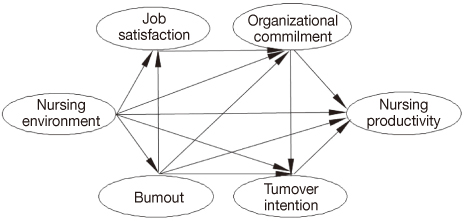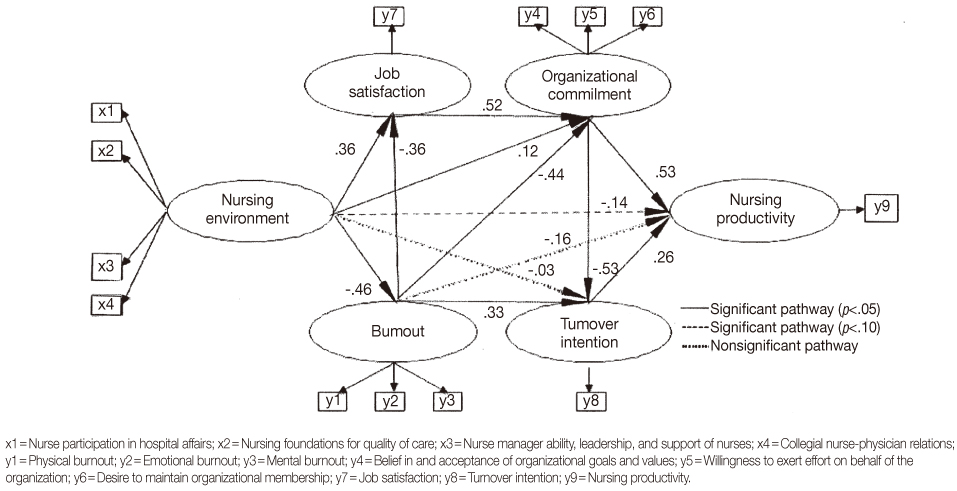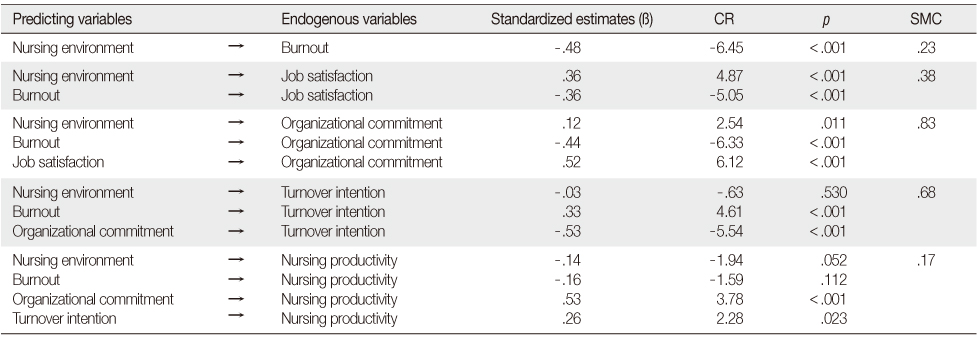Articles
- Page Path
- HOME > J Korean Acad Nurs > Volume 43(1); 2013 > Article
-
Original Article
- Structural Equation Modeling on Nursing Productivity of Nurses in Korea
- Se Young Kim, Eun-Kyung Kim, Heon Man Lim, Mi Young Lee, Kwang-Ok Park, Kyoung A Lee
-
Journal of Korean Academy of Nursing 2013;43(1):20-29.
DOI: https://doi.org/10.4040/jkan.2013.43.1.20
Published online: February 28, 2013
1College of Nursing, Eulji University, Daejeon, Korea.
2Department of Nursing, Chungbuk National University, Cheongju, Korea.
3Appenzeller School of Public Administration, Paichai University, Daejeon, Korea.
4Nursing Department, Eulji University Hospital, Daejeon, Korea.
5Department of Nursing, Sunchon National University, College of Life Science and Natural Resources, Sunchon, Korea.
6The Research Institute of Nursing Science, Seoul National University, Seoul, Korea.
- Address reprint requests to: Kim, Eun-Kyung. Department of Nursing, Chungbuk National University, 52 Naesudong-ro, Heungduk-gu, Cheongju Chungbuk 361-763, Korea. Tel: +82-43-249-1730, Fax: +82-43-249-1711, kyung11@chungbuk.ac.kr
© 2013 Korean Society of Nursing Science
Abstract
-
Purpose
- The purpose of this study was to propose and test a predictive model that could explain and predict nursing productivity.
-
Methods
- A survey using a structured questionnaire was conducted with 360 nurses in Korea. The data were analyzed using SPSS Windows 18.0 and AMOS 19.0 program.
-
Results
- Based on the constructed model, burnout and organizational commitment were found to have direct effects on nurses' turnover intention and nursing productivity. While nursing work environment was found to have indirect effects on nurses' turnover intention and nursing productivity.
-
Conclusion
- This structural equational model is a comprehensive theoretical model that explains the related factors and their relationship with nursing productivity. Comprehensive organizational interventions to improve nursing productivity should focus on improving the nursing work environment. Findings from this study can be used to design appropriate strategies to decrease nurse turnover in Korea. Further studies are needed to prospectively verify these causal relationships with larger samples.
- 1. Aiken LH, Clarke SP, Sloane DM, Lake ET, Cheney T. Effects of hospital care environment on patient mortality and nurse outcomes. J Nurs Adm. 2008;38(5):223–229. http://dx.doi.org/10.1097/01.NNA.0000312773.42352.d7.ArticlePubMedPMC
- 2. Aiken LH, Clarke SP, Sloane DM, Sochalski J, Silber JH. Hospital nurse staffing and patient mortality, nurse burnout, and job dissatisfaction. JAMA. 2002;288(16):1987–1993. http://dx.doi.org/10.1001/jama.288.16.1987.ArticlePubMed
- 3. Baernholdt M, Mark BA. The nurse work environment, job satisfaction and turnover rates in rural and urban nursing units. J Nurs Manag. 2009;17(8):994–1001. http://dx.doi.org/10.1111/j.1365-2834.2009.01027.x.ArticlePubMedPMC
- 4. Bain DL. The productivity prescription: the manager's guide to improving productivity and profits. 1982;New York, McGraw-Hill.
- 5. Cho E, Choi M, Kim EY, Yoo IY, Lee NJ. Construct validity and reliability of the Korean version of the practice environment scale of nursing work index for Korean nurses. J Korean Acad Nurs. 2011;41(3):325–332. http://dx.doi.org/10.4040/jkan.2011.41.3.325.ArticlePubMed
- 6. Coomber B, Barriball KL. Impact of job satisfaction components on intent to leave and turnover for hospital-based nurses: A review of the research literature. Int J Nurs Stud. 2007;44(2):297–314. http://dx.doi.org/10.1016/j.ijnurstu.2006.02.004.ArticlePubMed
- 7. Eaton-Spiva L, Buitrago P, Trotter L, Macy A, Lariscy M, Johnson D. Assessing and redesigning the nursing practice environment. J Nurs Adm. 2010;40(1):36–42. http://dx.doi.org/10.1097/NNA.0b013e3181c47d04.ArticlePubMed
- 8. Ha NS, Choi J. The relationship among leadership styles of nurse managers, job satisfaction, organizational commitment, andturnover intention. J Korean Acad Nurs. 2002;32(6):812–822.ArticlePDF
- 9. Ha NS, Park HM. The effects of perception of internal marketing on performance of nursing organization. Clin Nurs Res. 2007;13(2):7–16.
- 10. Hair JF, Black B, Babin B, Anderson RE, Tatham RL. Multivariate data analysis. 2006;6th ed. New York, Prentice Hall.
- 11. Ingersoll GL, Olsan T, Drew-Cates J, DeVinney BC, Davies J. Nurses' job satisfaction, organizational commitment, and career intent. J Nurs Adm. 2002;32(5):250–263. http://dx.doi.org/10.1097/00005110-200205000-00005.ArticlePubMed
- 12. Jeong JH. Structural equation modeling on nursing productivity of nurses in a hospital. 2008;Seoul, Chung-Ang University. Unpublished doctoral dissertation.
- 13. Jeong YM, Kang YS. The effect of job stress and burnout by job environment of care-givers on job satisfaction. J Korea Acad Ind Coop Soc. 2010;11(10):3688–3699. http://dx.doi.org/10.5762/KAIS.2010.11.10.3688.Article
- 14. June KJ, Byun SW. Nurse's burnout research throughout the past 10 years in Korea. J Korean Acad Nurs Adm. 2009;15(3):305–313.
- 15. Kim HK, Ji HS, Ryu EK, Lee HJ, Yun SE, Jeon MK, et al. Factors influencing on burnout of the nurses in hospitals. Clin Nurs Res. 2005;10(2):7–18.
- 16. Kramer M, Schalenberg C. Essentials of a magnetic work environment, part 1. Nursing. 2004;34(6):50–54.Article
- 17. Lake ET. Development of the practice environment scale of the Nursing Work Index. Res Nurs Health. 2002;25(3):176–188. http://dx.doi.org/10.1002/nur.10032.ArticlePubMed
- 18. Lee HJ. Predictors of job performance, work satisfaction, and productivity among Korean hospital nurses. J Korean Acad Nurs Adm. 2001;31(4):571–583.ArticlePDF
- 19. Lee MH. Relationship between organizational culture types and organizational effectiveness in hospitals. 1998;Daejeon, Chungnam National University. Unpublished doctoral dissertation.
- 20. Lee YJ, Kim KB. Experiences of nurse turnover. J Korean Acad Nurs. 2008;38(2):248–257. http://dx.doi.org/10.4040/jkan.2008.38.2.248.Article
- 21. McNeese-Smith D. Job satisfaction, productivity, and organizational commitment. The result of leadership. J Nurs Adm. 1995;25(9):17–26. http://dx.doi.org/10.1097/00005110-199509000-00006.
- 22. McNeese-Smith DK. A nursing shortage: Building organizational commitment among nurses. J Healthc Manag. 2001;46(3):173–186.ArticlePubMed
- 23. Moody RC. Nurse productivity measures for the 21st century. Health Care Manage Rev. 2004;29(2):98–106. http://dx.doi.org/10.1097/00004010-200404000-00003.ArticlePubMed
- 24. Moon SJ, Han SS. A predictive model on turnover intentionof nurses in Korea. J Korean Acad Nurs. 2011;41(5):633–641. http://dx.doi.org/10.4040/jkan.2011.41.5.633.ArticlePubMed
- 25. Oh YH, Jo JG, Kim JH, Ji YG. Mid-to long-term supply and demand projection of healthcare workforce. 2010;Seoul, National Health Personnel Licensing Examination Board.
- 26. Park GJ, Kim YN. Factors influencing organizational commitment among hospital nurses. J Korean Acad Nurs Adm. 2010;16(3):250–258.Article
- 27. Park HS. Relationship between perceived nursing care role orientation, job characteristics, and turnover among nurses. 2002;Yonsei University, Seoul. Unpublished master's thesis.
- 28. Park JS, Park BN. The influence of empowerment on job satisfaction, task performance and turnover intention by hospital nurses. J Korean Acad Nurs Adm. 2008;14(2):150–158.
- 29. Park KO. A study of variables related to nursing productivity. J Nurs Acad Soc. 1994;24(4):584–596.ArticlePDF
- 30. Peltier J, Nill A, Schibrowsky JA. Internal marketing, nurse loyalty and relationship marketing: An exploratory study of German nurses. Health Mark Q. 2003;20(4):63–82. http://dx.doi.org/10.1300/J026v20n04_05.PubMed
- 31. Shields MA, Ward M. Improving nurse retention in the National Health Service in England: The impact of job satisfaction on intentions to quit. J Health Econ. 2001;20(5):677–701. http://dx.doi.org/10.1016/S0167-6296(01)00092-3.ArticlePubMed
REFERENCES
Figure & Data
REFERENCES
Citations

- Psychometric Properties of the Korean Version of Self-Efficacy for HIV Disease Management Skills
Gwang Suk Kim, Layoung Kim, Mi-So Shim, Seoyoung Baek, Namhee Kim, Min Kyung Park, Youngjin Lee
Journal of Korean Academy of Nursing.2023; 53(3): 295. CrossRef - Effect of Job Embeddedness on Turnover Intention of Nurses in Long Term Care Hospitals: The Mediating Effect of Nursing Work Environment
Sun Mi Ha, Yeong Ju Ko
Journal of Korean Academy of Nursing Administration.2020; 26(5): 439. CrossRef - A Meta-Analytic Path Analysis on the Outcome Variables of Nursing Unit Managers' Transformational Leadership: Systemic Review and Meta-Analysis
Sunmi Kim, Seok Hee Jeong
Journal of Korean Academy of Nursing.2020; 50(6): 757. CrossRef - Clinical nurses’ beliefs, knowledge, organizational readiness and level of implementation of evidence-based practice: The first step to creating an evidence-based practice culture
Jae Yong Yoo, Jin Hee Kim, Jin Sun Kim, Hyun Lye Kim, Jung Suk Ki, Tim Schultz
PLOS ONE.2019; 14(12): e0226742. CrossRef - Relationship among Nursing Professionalism, Nursing Work Environment, and Patient Safety Nursing Activities in General Hospital Nurses
Mi-Aie Lee, Sunjoo Kang, Hye Sun Hyun
Journal of Korean Academy of Nursing Administration.2019; 25(4): 317. CrossRef - Influence of Emotional Intelligence, Communication, and Organizational Commitment on Nursing Productivity among Korean Nurses
Hyo Geun Geun, Eunok Park
Journal of Korean Academy of Community Health Nursing.2019; 30(2): 226. CrossRef - Impact of Burnout on Organizational Outcomes, the Influence of Legal Demands: The Case of Ecuadorian Physicians
Paola Ochoa
Frontiers in Psychology.2018;[Epub] CrossRef - Effects of Nurses' Social Capital and Job Engagement on Nursing Performance: Focused on the Mediating effects of Organizational Citizenship Behavior
Mi Soon Ko, Hyunsook Zin Lee, Myung Suk Koh
Journal of Korean Academy of Nursing Administration.2017; 23(1): 42. CrossRef - Mediating Effect of Social capital between Transformational leadership and Organizational Commitment of Nurses in Hospitals
Soon-gu Kim, Young-sook Seo
Journal of the Korea Academia-Industrial cooperation Society.2016; 17(2): 282. CrossRef - Relationship of between Task Performance, Job Satisfaction, and Organizational Contribution of Dental Hygienists
Jun-Yeong Kwon, Su-Young Lee
Journal of dental hygiene science.2016; 16(4): 302. CrossRef - A Path Analysis of Variables Influencing customer orientation of Hospital Nurses
Eun-Su Do, Young-Sook Seo
Journal of Digital Convergence.2016; 14(1): 275. CrossRef - Nurses' Perception of Organizational Commitment, Nursing Work Environment, and Social Support in a General Hospital
Sook Bin Im, Mi Young Lee, Se Young Kim
Journal of Korean Academy of Nursing Administration.2015; 21(1): 1. CrossRef - Literature Review of Structural Equation Models for Hospital Nurses' Turnover Intention in Korea
Eunhye Kim, Jinhyun Kim
Perspectives in Nursing Science.2014; 11(2): 109. CrossRef - Clinical Nurses' Experience of Positive Organizational Culture
Young-Hee Yom, Sang Mi Noh, Kyung Hee Kim
Journal of Korean Academy of Nursing Administration.2014; 20(5): 469. CrossRef - Factors Affecting Intensive Care Units Nursing Workload
Mohammad Karim Bahadori, Ramin Ravangard, Mehdi Raadabadi, Seyed Masod Mosavi, Mohammad Gholami Fesharaki, Fardin Mehrabian
Iranian Red Crescent Medical Journal.2014;[Epub] CrossRef - Comparison of Hospital Nurses' Recognition of the Team System and Effects on the Nursing Organizational Team System
Kwang-ok Park, Sung Hee Park, Mi Yu
Journal of Korean Academy of Nursing Administration.2014; 20(4): 414. CrossRef


Figure 1
Figure 2
Pearson Coefficient Correlation for Measured Variables (N=360)
*Correlation is significant at the 0.05 level (2-tailed); **Correlation is significant at the 0.01 level (2-tailed).
Parameter Estimates and SMC of Modified Structural Model (N=360)
CR=Critical ratio; SMC=Squared multiple correlation.
Effect of Predictor Variables in the Modified Model (N=360)
SMC=Squared multiple correlation.
*p<.05; **p<.01.
*Correlation is significant at the 0.05 level (2-tailed); **Correlation is significant at the 0.01 level (2-tailed).
CR=Critical ratio; SMC=Squared multiple correlation.
SMC=Squared multiple correlation. *
 KSNS
KSNS
 E-SUBMISSION
E-SUBMISSION





 Cite
Cite

